 AN INTERVIEW WITH
AN INTERVIEW WITH 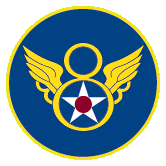
CAPT. ARTHUR HEIDEN
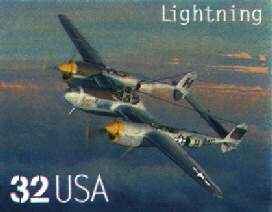 USPS Stamp featuring "Lucky Lady" 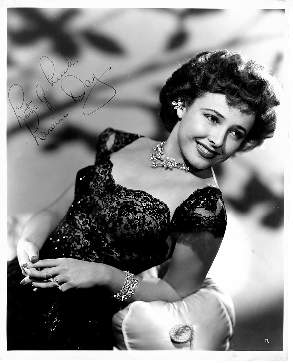 Actress Laraine Day, whose photograph was on the nose of Heiden's P-38 "Lucky Lady" 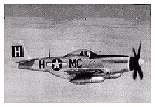 Capt. Heiden's P-51D, which he never named. 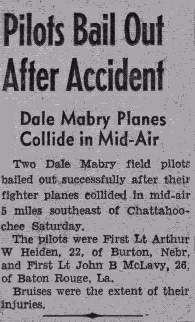 |
Q.: Your aircraft, "Lucky Lady" (P-38-J10-LO serial #42-67427, squadron code MC-H) was chosen by Bill Phillips as the P-38 to be portrayed in the "Classic American Aircraft Series" of stamps for the USPS. What was your reaction when you first heard about this? AWH: The S/N and J model has never really been resolved as it is. For some reason the serial number had been scrubbed from the area on the gondola, just below the left wing leading edge. The S/N that has been used is really From my old painted P-38 that crashed on 4-23-44 by either Vernon Beasley or Al Learned trying to get home after being badly shot up. Q.:I have seen records that the aircraft was #42-104086, originally coded MC-F while Maj. Franklin was the pilot. There are pictures showing clearly that the serial number was missing while he was still flying her. David Knight, of the 20th. Fighter Group Historical Society seems to agree with this info. AWH:David has most of that stuff right-on. You are right about the Sq. letters for MC-F = Franklin. Both the P-38 and P-51s I flew were coded MC-H. � Q.:What was your reaction when you first saw the stamp? AWH: Jack Ilfrey called and told me about it -- I thought he was pulling my leg! I had seen the panel of stamps mentioned in magazines like "Air & Space", but had not paid close attention that the P-38 was of Lucky Lady. Was a very nice feeling, but I started worrying about the flak I would get from all the other P-38 drivers. However they have been kind. Still would like to know how it happened? First, I have to blame Jack as he knew Phillips and have always been happy with the art work and that something vulgar hadn't been chosen. Q.: "Lucky Lady carried a picture of actress Laraine Day on the nose, was this a decision you or the crew made? AWH: Lt. Pierson & I had played around with naming our A/C the "Lonesome Pole Cat" and the "Shiftless Skunk", but my old A/C crashed and Pierson moved over to 55thFS and was later lost. I was reassigned Franklin's A/C and Ground crew. Max had mentioned that we should rename this A/C something other than "Strictly Stella's Baby". So one day we were all at the A/C and Max sets us down under the R/Wing and asks me what should be the new name. I asked if anyone had a good name, but no one came up with one. I had been playing around with an inspiration, "Lucky Lady" so we would not be held down to only one girl friend and could be related to by all the crew and no tattoo to be embarrassed by later. The crew were quick to approve so that was decided. Q.: Who wrote her for the photograph? AWH: Laraine Day was very popular, at that time with lonesome GI's, so Max asked us what we would think if he should write her and ask for a photo. Miss Day promptly answered with a nice letter and a beautiful negligee photo.It was promptly attached to the L/gun door. Q.: So was the actual picture itself placed on the aircraft or did someone paint her likeness on it? AWH: I have recently asked Max how they did this so well and protected it from condensation and other moisture, but he doesn't remember. As Bong had done this I guess the technique was well known. He remembers a compound that was in use at that time called "Water Glass". He remembers it being used to waterproof canvas like tents and Jeep tops. Sounds like the wood glue that people use for art work (decoupage) that dries clear. Plexiglas cover and frame with some type of rubberized sealing. Max and the crew wrote back and forth with Miss Day and she seemed very proud and interested in all events her airplane was involved in. Q.: You have been quoted as saying that a pilot's heroes were his ground crew, and you are still close with T/Sgt. Max Pyles, your crew chief during the war, tell me alittle about Max and your crew... AWH: Max Pyles is gifted with a superhuman mechanical ability and insite. This he demonstrated in WWII, Korean War, and Cold War in all types of aircraft, P-26's to B-36's to Jet's to ICBM's. Many times, I've asked him how on earth he came up with answers and perceptions to things that stooped others cold. He just Grins and says it's like a flash bulb going off in his head. Dead serious, he believs that the Lord tells him. I would not believe any other man telling me that, but I sure won't argue with him. � � � When I started flying with the 79thFS, Max and his crew had just started crewing Maj. R. C.� Franklin's new airplane. Parked directly in front of the SQ. Operations building he was handy and always willing to answer any and all questions I might ask him. There I spent most of my time. I'm sure we were observed by Franklin and he had asked Max if he should run me off. However, when Franklin finished his combat tour, Max asked him to assign me as his replacement since my old plane had just been destroyed. � � � P-38's were having all kinds of mechanical problems that no one except Max had an answer. Max had been saying that this situation was ridiculous and if I would listen to him and do as he said we were going to get through this without all those problems. I had listened to him for several months and was convinced that Max Pyles knew what he was talking about. Besides being very proud of the opportunity of this assignment, I was determined to do my part. Strong willed as could be, Max had no trouble expressing or letting anyone know how it should be. Max would be delighted to help anyone or answer there questions, but Private or Field Grade better not come around with Mickey Mouse or they had down-the-road directions. My contributions were to listen, ask questions, and try to build on what I had learned in Aircraft Mechanics School and in Flying School. What better world could you have with such as Max Pyles, R.C.Franklin, Mark Hubbard, and Harold Rau as superb teachers? Q.: In the past we have talked about the discrepancies in records that have led up to many arguments over many pilots confirmed number of air victories, what is your take on all of this? AWH: The whole subject of confirmed victories is a mess. God only knows. As an example, I seriously question victory records, especially Rau, Bradshaw and Wilson's. As to the two I got in Lucky Lady, I really don't have a comment. � � � �� I am guessing here, that the Claims Review Office was confronted with the problem of comparing the claims, from day to day, with the intelligence gathering of Luftwaffe combat capabilities. These would differ as much as 100%. Reality had to prevail. I could see Rau & Wilson telling Claims Review to deduct from their claims before those of the line pilots. Also, there was the fact that they were busy leading and distracted from trying to make certain of their gunnery. Q.: What were the requirements, as you remember them, for a confirmed victory? AWH: Victory claims requirements were to have seen the enemy aircraft on fire, or crash, or pilot bailout, or disintegrate. Best to have another witness. A big problem was smoke as an engine at full throttle could lay down lots of smoke. Obliviously, a "smoker" was generally claimed and that was the problem and others that appeared out of control. Rau and Wilson would not have had time to follow any cripples to confirm that they crashed. At debriefings, a pilot had no real proof other than to let the gun-camera be the witness. Even then, the P-38 gun camera film was so bad that it was next to useless because the camera was mounted in the nose with the guns. On P-38L's the camera was relocated to the external mounts pylon. Q.: There are pictures of you and the crew with "Lucky Lady" that show three kills on her, but they appear to be left over from when Maj. Franklin flew the aircraft as they are situated differently than the two shown in later pictures of the aircraftwhen you flew it. I know that has led to some confusion among us enthusiasts... AWH: That sounds logical. Painting Swastikas on the airplanes were left to the ground crews. For their entertainment, they would get the film as soon as they could and make their own determinations on what they would paint on the A/C. Q.: In retrospect do you remember any specific missions as being very rough? AWH: Toughest missions? Early escort missions were extremely tough. With Spring of '44, we started strafing heavily defended airfields. These could generally be murderous, especially if multiple passes were carried out. I have strafed where there was no return fire and others where the smoke was so thick you nearly had to go on instruments and every A/C was hit. With these, simple deduction, told you that survival was next to nil. With Escort missions and Air to Air Combat most would stay in combat for the duration -- A fighter pilots dream. Of course, that was from the Spring of '44 on when the 10 to 1 ratio had been reduced and also the Luftwaffe pilot quality. Q.: You have told me about some eight-plane missions that were flown that there aren't alot of mention of. Were these primarily bomb runs, escorts of recon. planes or strafing missions? AWH:� Note that some 8-plane missions are not recorded in King's Cliffe"(the book which Chronicles the 20th.FG History). As you state these were as you guessed, bombing, escort of other low level missions for CAP or diversion, escorting weather or recon and such. I recall being sent out on the deck (very low) to skip bomb bridges. One I remember, Capt. W. W. Smith & I with a two-flight section were sent after a�rail-bridge in the low country North of Paris. We used heading changes and other formations for diversion, picked up our nav brackets and headed for the bridge. Reaching the river, just a big ditch, with a bridge without superstructure, W. W. reported that he didn't have it in view at about the time it came up on my side. I told him that I had it and to follow me. With delayed bomb fuses, all four of us stuck our bombs into the embankments. With the four 1000 pounders that bridge disentragated and rose way up in the air -- right into W. W.'s face. He survived, but talk about upset! We considered these missions fun and welcomed the freedom to freelance as we did when we were sent out as spares for escort missions. Q.: We spoken before about the differences between the Lightning and the Mustang, is it true that many pilots were really gung ho about the Mustang and it helped to boost morale... AWH: For most of us, the P-38 was our first love and in many ways a test of our manhood. To most of us, the P-51 transition was just something new and exciting. Col. Wilson gave us a good sales job and it was a modern aircraft, modern systems, and a new challenge. It had gained a great reputation by the time we got them. All the conversation was just so much BS that floats around. Doubt that anyone realized how the flood of P-51's and pilots would become so significant. The thoughtless crap we endured in print, after the war, was what stirred up old P-38 pilots. You, Corey, Carlo and JJ (members of a e-mail list that features several webmasters, aviation writers and USAAF/USAF veterans, including Capt. Heiden) have forced a reanalysis that even we were not getting deep enough into. I am excited about this and am impatiently waiting on the things in the works. Q.: Did you have any time to get acquainted with the P-51 when the transition happened? Was there any apprehension about going from the added safety margin of a twin-engined aircraft to a single? AWH: We did have a short time to get familiar with the P-51, but it was fun. We liked the Merlin engine and its ability to take 61"HG for extended periods, the new K-14 "no miss um" gun sight grew on us, the comfort, 7 hour missions were hard on the rear but extended our world and feeling of usefulness. The one engine business crossed our minds, especially over the North Sea, but wasn't a big deal. The accusation that the 51 had more range, well, countered with the fact of not having 38L's and 300gal tanks (3 hours more) in the ETO made that argument stupid. Q.: You have stated you thought that training in the early part of the war was "ridiculous" and lacked alot of the necessary seat time. Did you get any assistance from the squadron's vets? AWH: Training and transition were anything but optimum during all of WWII. We just had to figure it out -- study the manuals, learn the numbers and quirks from any available source. When we transitioned to 51's we had one per Sq. and were directed to get 5hrs, we did a lot of take-offs and landings. Not enough time to mix it up with each other. The new aircraft was starting to come in, and were prepped. We probably flew them once or twice. No gunnery, we hadn't got to use that new gyro gun sight(K-14) before combat. That was troubling, for it had to be set up for combat. Set in the wing span and the turn the motorcycle grip on the throttle to capture the target. We were surprised it worked great. It wasn't till well into '45 that replacements had any 51 time and then only 10hrs transition, no gunnery in it, even up to VE-Day. Q.: Was there a period where you had to grow used to the difference in having the firepower out in front of you, as in the P-38, to the three-to-a-side configuration of the P-51? AWH:38/51 guns were of no problem, another bunch of BS. K-14 gun sight and an emphasis on gunnery training in RTU's was a tremendous improvement. Q.: When you and the other replacement pilots arrived did you receive any training or help from the veteran pilots there? AWH: Veteran pilots did try to help us new replacements as best they could. Most important was that Col Hubbard set up several training/engineering flights. Weather was a bit of a problem and they wanted to get us as comfortable as possible before sending us out in bad weather. They took us on a milk-run mission out over the French Coast and waited for another good day to take us on a real mission. Formation climb-outs and mission returns in bad weather was a scarry thing for us and for the older guys with a bunch of people who had never had the expierence. Q.:It has been said that many of the losses of USAAF pilots in the ETO can directly be attributed to mechanical problems... AWH: Mechanical loses were the predominate factor. However, most losess can be atributed to training in full or in part especially with the season/weather factors. Lack of individual combat training would be telling also. Remember being up on a slow-time flight. Out of boredom, I bounced Capt. Bob Meyers as he was on take off. He proceded to give me a terrible working over and chewing out. It gave a valuable lesson and change of attitude. Embarassed, I vowed I would never let that happen to me again. Q.: What was the Group's reaction to Arch Whitehouse's story, "The Loco Boys Go Wild"? AWH: It came out in November 0f 1944, so it was on the stands after I had returned Z of I. Hence, I don't know if anyone got to see it while in Combat. Q.: After your combat tour with the 20th.FG where you assigned next? AWH: After returning to the States I was assigned to a single-engine RTU at Tallahassee, FL. Of course there, they were flooded with military, but always treated exceptionaly well. Q.: Looking back now what do remember the morale being during your time in the ETO? AWH: At first, no one was telling us that we were winning any war. We did what we could and we are all proud of our effort. It would have been nice to have received two or three times as many pilots and airplanes and been able to make some flashy records. However, King's Cliffe was a very small field and had trouble getting all three Squadrons on it. I hope we gave some comfort to many bomber crews. |
RETURN TO A TRIBUTE TO CAPT. HEIDEN
CAPT. HEIDEN TALKS ABOUT THE P-38 AND P-51
PILOT TALK, A SERIES OF E-MAILS FROM CAPT. HEIDEN AND COL. EUGENE CARSON
A LETTER FROM CAPT. HEIDEN TO MARTIN CAIDIN
RETURN TO THE 20TH.FG
Unless otherwise noted, all content � copyright The Art of Syd Edwards 1998-1999. All rights reserved and reproduction is prohibited.
